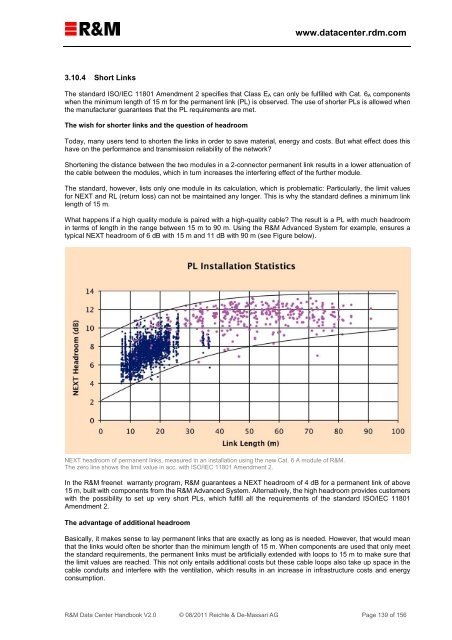R&M Data Center Handbook
R&M Data Center Handbook
R&M Data Center Handbook
You also want an ePaper? Increase the reach of your titles
YUMPU automatically turns print PDFs into web optimized ePapers that Google loves.
www.datacenter.rdm.com<br />
3.10.4 Short Links<br />
The standard ISO/IEC 11801 Amendment 2 specifies that Class E A can only be fulfilled with Cat. 6 A components<br />
when the minimum length of 15 m for the permanent link (PL) is observed. The use of shorter PLs is allowed when<br />
the manufacturer guarantees that the PL requirements are met.<br />
The wish for shorter links and the question of headroom<br />
Today, many users tend to shorten the links in order to save material, energy and costs. But what effect does this<br />
have on the performance and transmission reliability of the network<br />
Shortening the distance between the two modules in a 2-connector permanent link results in a lower attenuation of<br />
the cable between the modules, which in turn increases the interfering effect of the further module.<br />
The standard, however, lists only one module in its calculation, which is problematic: Particularly, the limit values<br />
for NEXT and RL (return loss) can not be maintained any longer. This is why the standard defines a minimum link<br />
length of 15 m.<br />
What happens if a high quality module is paired with a high-quality cable The result is a PL with much headroom<br />
in terms of length in the range between 15 m to 90 m. Using the R&M Advanced System for example, ensures a<br />
typical NEXT headroom of 6 dB with 15 m and 11 dB with 90 m (see Figure below).<br />
NEXT headroom of permanent links, measured in an installation using the new Cat. 6 A module of R&M.<br />
The zero line shows the limit value in acc. with ISO/IEC 11801 Amendment 2.<br />
In the R&M freenet warranty program, R&M guarantees a NEXT headroom of 4 dB for a permanent link of above<br />
15 m, built with components from the R&M Advanced System. Alternatively, the high headroom provides customers<br />
with the possibility to set up very short PLs, which fulfill all the requirements of the standard ISO/IEC 11801<br />
Amendment 2.<br />
The advantage of additional headroom<br />
Basically, it makes sense to lay permanent links that are exactly as long as is needed. However, that would mean<br />
that the links would often be shorter than the minimum length of 15 m. When components are used that only meet<br />
the standard requirements, the permanent links must be artificially extended with loops to 15 m to make sure that<br />
the limit values are reached. This not only entails additional costs but these cable loops also take up space in the<br />
cable conduits and interfere with the ventilation, which results in an increase in infrastructure costs and energy<br />
consumption.<br />
R&M <strong>Data</strong> <strong>Center</strong> <strong>Handbook</strong> V2.0 © 08/2011 Reichle & De-Massari AG Page 139 of 156


